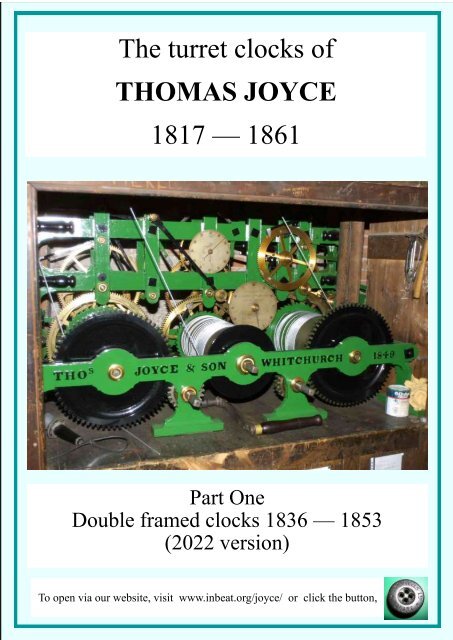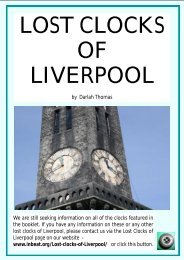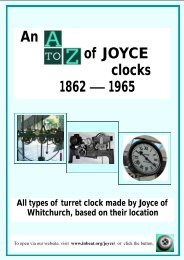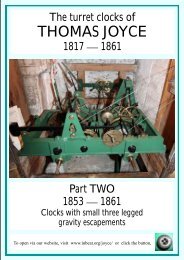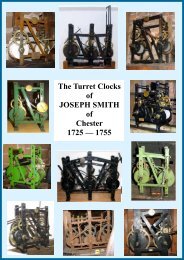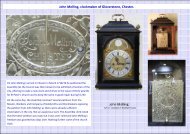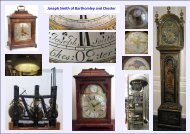Turret Clocks of Thomas Joyce. Part 1
Updated version of booklet showing images and information about 26 clocks and several which are now 'lost'.
Updated version of booklet showing images and information about 26 clocks and several which are now 'lost'.
Transform your PDFs into Flipbooks and boost your revenue!
Leverage SEO-optimized Flipbooks, powerful backlinks, and multimedia content to professionally showcase your products and significantly increase your reach.
The turret clocks <strong>of</strong><br />
THOMAS JOYCE<br />
1817 — 1861<br />
<strong>Part</strong> One<br />
Double framed clocks 1836 — 1853<br />
(2022 version)<br />
To open via our website, visit www.inbeat.org/joyce/ or click the button,
1. St Mary’s, Tallarn Green, near Whitchurch 1836<br />
1.A two train, chair framed clock <strong>of</strong> unusual design at St Mary Magdalene, Tallarn Green, near<br />
Whitchurch. There is a brass plaque which is engraved ‘THOS JOYCE WHITCHURCH’, but no<br />
date is given. It is believed to be the earliest <strong>Thomas</strong> <strong>Joyce</strong> turret clock we have seen. It was<br />
moved from its original location and installed here.<br />
A service <strong>of</strong> blessing for the new tower and clock was held on 22nd October 1888, but the<br />
clock’s installation was at least fifty years later than its date <strong>of</strong> manufacture.<br />
Left: A drawing <strong>of</strong> this clock was found in a book <strong>of</strong><br />
apprentice work created by James <strong>Joyce</strong>(2) c. 1836.<br />
He gave it the title ‘Savings Bank’, giving a clue to the<br />
clock’s original location.
2. St Catherine’s Church, Dodington, Whitchurch 1839<br />
2. St Catherine’s Church, Dodington, Whitchurch. This had a two train clock which was located<br />
in the church until the 1980s when the church was de-consecrated - the owner has told us the<br />
clock was removed - only the dial remains. The building’s Grade ll listing details give its<br />
construction date as 1836; the clock is believed to have been dated 1838; the photos we have<br />
date from early 1977. This clock was seen for sale on the internet in 2012.
3. Combermere Abbey 1839<br />
Combermere Abbey - A rare time piece, <strong>of</strong> exuberant design similar, but not identical to clock<br />
18. It has a dead beat anchor escapement, maintaining power, cast iron frame sections, a wooden<br />
barrel and its setting dial is engraved ‘Thos <strong>Joyce</strong> Whitchurch 1839’. The clock drove one small<br />
dial located above an archway entrance to a stable courtyard. Access to the movement was via a<br />
very tall, free standing ladder and trap door, so winding was achieved via an external mechanism<br />
at ground level under the arch. The clock is no longer operational.
4. St St Deiniol’s Church, Worthenbury, Flintshire c.1840<br />
A two train double frame clock in St Deiniol’s Church, Worthenbury, Flintshire, (now part <strong>of</strong><br />
Wrexham County Borough) Undated, but stylistically this clock predates others on the following<br />
pages. Its setting dial records ‘THOS JOYCE WHITCHURCH’.<br />
Attributes indicate that this is one <strong>of</strong> the first <strong>of</strong> this group.
5. St Luke’s Church, Holmes Chapel, Cheshire 1841<br />
A large, three train double frame clock, converted to gravity escapement, in St Luke’s Church,<br />
Holmes Chapel, Cheshire, with ‘JOYCE WHITCHURCH SHROPSHIRE 1841’ cast into the frame.<br />
The mechanism has been converted to a double three-legged gravity escapement and is auto-wound.
6. St Mary’s, Cheadle, Cheshire 1841<br />
A large, three train double frame clock now converted to electric operation at St Mary’s Church,<br />
Cheadle, Cheshire, with ‘JOYCE WHITCHURCH SHROPSHIRE 1841’ cast into the frame. The<br />
clock has an enormous setting dial, (not visible in this image) engraved with the names <strong>of</strong> the<br />
rector, curate and churchwardens.<br />
This dial reads:<br />
TIME IS FLYING<br />
Another has:<br />
TRUST THE LORD<br />
And the third has:<br />
FORGET NOT GOD
7. Private house, Shropshire 1841<br />
A two train double frame clock in a private house in Shropshire, by Thos <strong>Joyce</strong>, dated 1841.
8. St Oswald’s, Malpas, Cheshire 1843<br />
A two train double frame clock in St Oswald’s Church, Malpas, Cheshire, with ‘JOYCE<br />
WHITCHURCH SALOP ’ cast into the frame and ‘<strong>Thomas</strong> <strong>Joyce</strong> Whitchurch June 1843 ’<br />
engraved on the setting dial. There is also a separate carillon by Gillett.
9. St Michael & All Angels, Marbury-cum-Quoisley,<br />
Cheshire 1844<br />
Similar to clock 4 on an earlier page, this clock is in St Michael and All Angels Church,<br />
Marbury-cum-Quoisley, Cheshire, with ‘JOYCE’ cast into its frame, which is dated 1844.<br />
Records still exist <strong>of</strong> this clock’s first overhaul which was not until 1955.
10. Holy Trinity Church, Bardsley, Oldham 1845<br />
Holy Trinity Church, Bardsley, Oldham. This has a two train clock with a dead beat anchor escapement<br />
and two seconds pendulum. The frame is cast with ‘THOS JOYCE & SON 1845’ and the large setting<br />
dial is engraved ‘THOS JOYCE & SON 1845 Whitchurch Salop’. The clock drives two external and one<br />
internal dial <strong>of</strong> a similar size, situated high on a wall above the west end <strong>of</strong> the nave.
11. St Michael’s Church, Middlewich, Cheshire 1846<br />
A large three train double frame clock with full quarter chiming; converted at an unknown date to a double<br />
three legged gravity escapement, from St Michael’s Church, Middlewich, Cheshire. It has ‘THOS JOYCE<br />
& SON WHITCHURCH 1846’ cast into the frame. The clock has been removed from the church and when<br />
we went to photograph it, it was dismantled at Whitchurch Heritage Centre.
12. St John’s Higher Broughton, Manchester 1846<br />
St John the Evangelist Church, Higher Broughton, Gr. Manchester. It has ‘THOS JOYCE & SON<br />
1846’ cast into the frame. The church is redundant so we were unable to photograph the clock,<br />
which we believe was still in place when we visited in 2012.<br />
Old photo <strong>of</strong> clock supplied by Carl Goldberg.
13. Nantwich Savings Bank, Welsh Row, Nantwich 1847<br />
A small, second phase double frame timepiece with ‘JOYCE 1847’ cast into its frame. It has been<br />
on display in the Whitchurch Heritage Centre. It is believed to have been removed from the<br />
old Nantwich Savings Bank. In 1846 the Savings Bank was built on Welsh Row, Nantwich, see<br />
an image <strong>of</strong> the building as it is today, below. The former dial position is visible.
14. St Mary’s, Alveley, Shropshire 1848<br />
A two train double frame clock at St Mary the Virgin Church, Alveley, Shropshire. This clock<br />
was undoubtedly made by <strong>Thomas</strong> <strong>Joyce</strong>, although its setting dial, dated 1848 records <strong>Thomas</strong><br />
Glase <strong>of</strong> Bridgnorth. He was a clock and watchmaker recorded in High Street, Bridgnorth in the<br />
1851 census; he was probably an agent/retailer.
15. St Luke’s Hodnet, Shropshire 1848<br />
A two train double frame clock at St Luke’s Church, Hodnet, Shropshire. ‘THOS JOYCE & SON<br />
1848’ is cast into the frame, but the letters CE & SO are obscured by a geared winder for the<br />
strike barrel. The setting dial is unnamed.
16. St Alkmund’s Church, Whitchurch, 1849<br />
The three train full quarter chiming double frame clock at St Alkmund’s Church, Whitchurch,<br />
with ‘THOS JOYCE & SON WHITCHURCH 1849’ cast into the frame. Prior to this clock, all the<br />
<strong>Thomas</strong> <strong>Joyce</strong> three train clocks had ting tang chimes—this was their first with a Westminster<br />
chime, although it predates the Palace <strong>of</strong> Westminster clock (Big Ben) by almost a decade.
17. Christ Church, Harpurhey, Manchester 1849<br />
Christ Church, Harpurhey, Greater Manchester. A two train double frame clock, with<br />
‘THOS JOYCE & SON WHITCHURCH 1849’ cast into the frame.
18. Shrewsbury Railway Station 1849<br />
18. A timepiece with double frame located at Shrewsbury Railway Station, resembling clock<br />
number 3 . It has ‘JOYCE & SON’ cast into the frame. It has a 2 seconds pendulum and there are<br />
two setting dials, one for minutes, the other for seconds, to enable the level <strong>of</strong> accuracy required<br />
by the railway. The clock is in beautiful condition and at the time <strong>of</strong> our visit was still hand<br />
wound.
19. St Swithun’s Church, Cheswardine, Shropshire 1849<br />
St Swithun’s Church, Cheswardine, Shropshire. This is a two train striking double frame clock with a ting tang<br />
machine which was added in 1897. The clock has all <strong>of</strong> the <strong>Thomas</strong> <strong>Joyce</strong> characteristics, but its frame has cast<br />
letters spelling ‘RODGERS 1849 DRAYTON’. A separate chiming machine was added in 1879, see below.<br />
George Rodgers was born in Whitchurch in 1819 and may well have been trained by the <strong>Joyce</strong>s. He is listed by<br />
Elliott as in Market Drayton 1840-71; the 1851 census recorded him in High Street, Market Drayton as a<br />
watchmaker employing 2 people. In 1871, he was still working as a watchmaker employing two men but had<br />
diversified into trade in ale and porter employing one man in that branch <strong>of</strong> his business.<br />
20. St John’s Church,<br />
Aldbury, Herts 1849<br />
Two train clock with detached two seconds<br />
pendulum, signed ‘THOS JOYCE & SON<br />
1849’. We were unable to visit this clock.
21. St Leonard’s Church, Woore, Shropshire 1850<br />
21. St Leonard’s Church, Woore, Shropshire. Woore is an early Celtic name meaning<br />
‘boundary’ as this village is in Shropshire, but the borders <strong>of</strong> both Staffordshire and Cheshire are<br />
nearby. The church was built in 1830-1 with the tower added in 1910. This has led to the belief<br />
that the clock may have been installed at that time, second-hand, having spent sixty years elsewhere.<br />
Further research is required.<br />
Like the clock at Cheswardine<br />
(number 19), this clock was cast with<br />
the name George Rodgers <strong>of</strong> Market<br />
Drayton. The date is also cast into the<br />
frame but only the digits 185- are<br />
now visible.<br />
This clock has been recently rediscovered<br />
by Robin Hutchinson. It<br />
was not recorded by <strong>Joyce</strong>’s nor does<br />
it appear in our book: JOYCE <strong>of</strong><br />
Whitchurch. Clockmakers 1690-<br />
1965.<br />
Image left by Steve Parkin.
22. Denbigh Public Library 1850<br />
22. Denbigh Public Library. This two train clock was being dismantled for repair and for auto<br />
-winding when we photographed it. Its frame is cast with ‘THOS JOYCE & SON 1849’and its<br />
setting dial is engraved ‘THOS JOYCE & SON Whitchurch Salop’.<br />
The dial had been removed when this photo was taken.
23. Christ Church, Tilstock, Shropshire 1850<br />
23, A small, second phase two train double frame clock in Christ Church, Tilstock, Shropshire, with<br />
‘JOYCE’ cast into its frame and ‘Thos <strong>Joyce</strong> & Son 1850’ engraved on the setting dial.
24. St George’s, Hyde, Gr Manchester 1853<br />
24. St George’s Church, Hyde, Greater Manchester. This is a three train ting-tang double frame<br />
clock, with ‘THOS JOYCE & SON WHITCHURCH 1853’ cast into the frame. This clock was<br />
not in running order when we visited.
25. St Collen’s, Llangollen 1853<br />
25. A two train double frame clock at St Collen’s Church, Llangollen, with ‘THOS JOYCE &<br />
SON WHITCHURCH 1853’ engraved on the setting dial . ‘JOYCE & SON’ is cast into the front<br />
<strong>of</strong> the frame. Separate <strong>Joyce</strong> quarter chiming machine.
26. Holy Trinity, Coalbrookdale, Shropshire 1853<br />
26. Holy Trinity Church, Coalbrookdale, Shropshire. A three train full quarter chiming double<br />
frame clock, with ‘THOS JOYCE & SON WHITCHURCH 1853’ cast into the frame. The clock<br />
was installed in July the following year.
Lost <strong>Clocks</strong><br />
Christ Church, Weston Point, Runcorn 1841<br />
Christ Church, Weston Point Runcorn. The church was one <strong>of</strong> three in the area built by the<br />
Weaver Navigation Trustees to enable workers from the Company’s boats to better use their<br />
Sundays than by drinking and gambling. Accounts were produced at regular intervals and one set,<br />
published in the Chester Chronicle recorded £78-0-0 paid to Messrs. <strong>Joyce</strong> for a clock on 30th<br />
May 1841. A new clock was purchased from <strong>Joyce</strong>’s after a fire here, so it is thought the first<br />
clock was destroyed. The church was declared redundant on 1st June 1995 and neighbouring<br />
industry has encroached to such an extent that access to the exterior (only) <strong>of</strong> the church is<br />
possible only with special permissions.<br />
Card postmarked 1905
Lost <strong>Clocks</strong><br />
Christ Church, Winsford, Cheshire 1841<br />
Like the church at Weston Point, Christ Church, Winsford was also built by the Weaver<br />
Navigation Trustees. It ceased use as a place <strong>of</strong> worship in March 1974 and was sold. It<br />
has since been demolished to allow road improvements. Its clock would have been a<br />
similar double frame clock to the one on the previous page.<br />
Bangor Cathedral, Caernarfonshire 1842<br />
The North Wales Chronicle <strong>of</strong> 18th October 1842 described this gift from the Bishop <strong>of</strong><br />
Bangor as a clock <strong>of</strong> ‘a very superior character’ with ‘perfect workmanship’. Other details<br />
included in the report were — its size: 5ft 6ins across with an 18 inch main wheel, barrels<br />
<strong>of</strong> solid mahogany, maintaining power, a half dead beat escapement, 13 foot compensated<br />
pendulum, 160 pound bob, brass wheels and polished steel pinions, two dials 3 foot 5<br />
inches in diameter <strong>of</strong> slate and as a three train clock with ‘ding dong’ quarters.<br />
The old birdcage clock in place before the <strong>Joyce</strong> clock was fitted, is now installed at<br />
Tre-Ysgawen Hall, Anglesey. A plaque on its frame records its removal from the cathedral by<br />
‘Mr <strong>Joyce</strong>’.
Lost <strong>Clocks</strong><br />
Christ Church, Wharton, Winsford, Cheshire 1849<br />
<strong>Thomas</strong> <strong>Joyce</strong> supplied a clock to Christ Church, Wharton, Winsford in 1849 at a cost<br />
<strong>of</strong> £50. A Latin inscription on the clock’s dial records the gift by John Dudley in memory<br />
<strong>of</strong> his wife. The clock was later replaced by a <strong>Joyce</strong> pinwheel <strong>of</strong> unknown date.
All the clocks in this booklet feature IN GREATER DETAIL in our book JOYCE <strong>of</strong><br />
WHITCHURCH Clockmakers 1690-1965. There is also the family genealogy and histories<br />
<strong>of</strong> each <strong>of</strong> the family’s clockmakers and <strong>of</strong> the company. The major part <strong>of</strong> the book is a<br />
photographic record <strong>of</strong> over 150 <strong>of</strong> their turret clocks; our aim was to photograph<br />
examples <strong>of</strong> each <strong>of</strong> the different models made by the company, but not all, as we would<br />
have had to visit between one and two thousand clocks. (The exact number was never<br />
recorded.)<br />
Hardback book 670 pages Over 1,500 illustrations, mostly in colour.<br />
SPECIAL PRICE £40 post free (normally £48 + £6.50 postage = £54.50)<br />
To buy the book at the discounted price, email us on steveanddarlah@inbeat.org<br />
Tell us you have read this booklet, and we will send you payment details.<br />
To see sample pages <strong>of</strong> the book visit www.inbeat.org/joyce/


